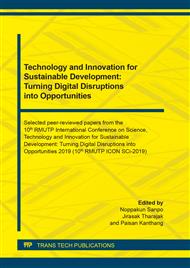p.57
p.65
p.73
p.79
p.89
p.95
p.103
p.109
p.113
Generating Electrical Performance of Plant Fuel System Using Hydroponic System Containing ZnO Nanoparticles
Abstract:
A variety of living organisms have a potential to generate the electrical currents which are alternative resources of electric power. Plant organisms absorb light radiation and convert electromagnetic energy to chemical energy via photosynthetic process. An electrical power is also generated from this process. However, a few amounts of currents are generated in this system. In this experiment, plants under the hydroponic system are used for studying the generation of electric power. Different ratios of tap water and Hoagland’s solution were used as culture solution. The cathode and anode were used as electrode in this system. Bioelectric potentials and currents of each treatment are detected at fifteen day of the generating system. The results showed that plant system under solution containing a high Hoagland’s nutrient generated current density and power density higher than those of the system containing a low Hoagland’s nutrient. However, plant system under solution containing a low Hoagland’s nutrient showed higher voltage than those of the system containing a high Hoagland’s nutrient. Metal oxide nanoparticles, known as photo-catalyst in fuel cell, were added in the solution of culture system and analyzed for electric power density. The result presented that ZnO nanoparticles affected a different increase in power density depending on the ratios of tap water and Hoagland’s solution.
Info:
Periodical:
Pages:
109-112
Citation:
Online since:
August 2020
Authors:
Keywords:
Price:
Сopyright:
© 2020 Trans Tech Publications Ltd. All Rights Reserved
Share:
Citation:


